|
2 Septembre 2012:
Still nothing seen here since 29 June. No activity.
Nothing... A few day's ago the top of my wooden mast broke "k
n a c k" during a storm.The Mini Whipe at the top did not fal at
the ground, but did hang at the coax cable upside down. The underside of
the Mini Wipe housing did act like a rain meter. In the past I did drill
a small hole next to the connector in the botem to give some ventilation
into the housing. Now it was just a water drain. It was possible to blow
air in it via the connector center pin. Water did spray out via the vent
hole. Finaly I put the whole antenna housing into a kitchen oven at abt.
60 degrees Celcius for 5 hours to make it dry inside. After that the
mini whipe did work as never befor... The Mini Wipe is now supported by
a part of a old bamboo fishing rod.
29 June 2012:
Still nothing seen here since 29 May. No activity.
Nothing...
29 May 2012:
Nothing seen here over the last month. No activity.
Nothing...
Well... I did some interesting test with OPERA in the
8KHz mode. I did decode my own generated signal in over a distance of 25
meters. I tried to generate low level signal as low as possible. The
maximum positive decoded transmission was -48dB at the Mini Whip antenne
who was also capturing the rest of the signals on VLF, like lightning,
switches and sideband interference of other OPERA testers :-)
Unfortunately that -48dB signal was still overloading a 47Uhz FFT
spectogram. It is not possible to compare it with the visual spectogram
decoding. What I try to say here is that OPERA in 8 KHz fails when the
signal is still loud and clear visible in a 48 uHz spectogram.
29 April 2012:
Last few day's I tried 3 notebook PC's here, with the intention to
generate a clean signal in a 47 uHz spectogram window. That seems not to
be that easy. Below a visual explanation of the results. At (A)
I started the test with a 10 year old ACER WinXP notebook. As you can
see the traces look like a widthband FM transmission :-). The
traces near (B) are not good visual
here, but look also terrible. I was testing here a 2 year jong ACER
Vista notebook. Then at (C) I took a 3rd
notebook from the loft, a 10 year old ASUS this time, and with
succes. As you can see the trace in the spectrogram is suddenly sharp (E)
like that white line at the middle of the road at 120 km/h.

The conclusion for the time beeing is, that it depends
on luck if you have a computer that is able to generate a rock stable
signal. All 3 tested computers where running Spectrum lab and locked
into a VLF station. What happens when you don't lock into a VLF station
is already described below on the 27nd of April...
While testing around 8970.1 was suddenly PA3CPM
visible near (D) on 8970.000 Hertz
in the spectogram above !!!
27 April 2012:
I did discovered that it is not easy to generate a VERY
stable signal with Spectrum Lab at 8970 Hz. I tried already two
notebooks. A 10 year old Acer did produce terrible traces at 47uHz.
But nice to see here (grab below) how good
that "Sampling rate detector" works. In the first few hours I
forgot to un-set the "measure only" option.... The signal
drifts all over the graph. Then it stabillizes when I did the adjustment
in the cfg. Unfortunately that 2th PC that I
test here, a "modern" 2 year old Acer Extensa 5235
notebook generates also a terrible trace at 47uHz. Take a look at the
pictures below. In that 424uHz and 238 uHz window it looks not that bad,
but in that 47Uhz window it looks not that good anymore...
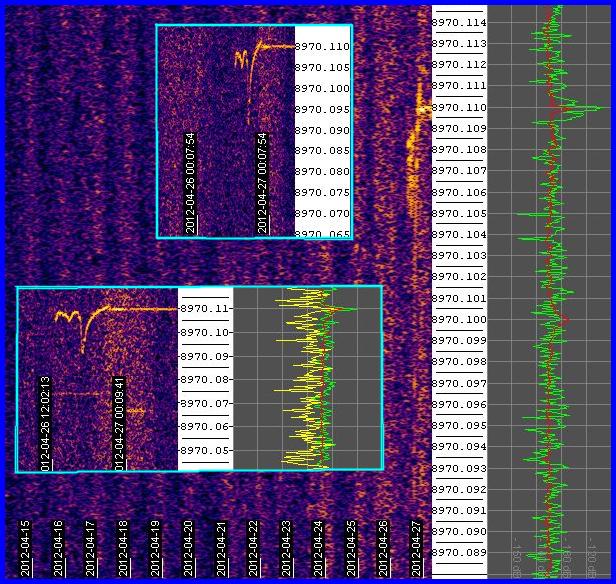
16 April 2012:
Uwe, DJ8WX and Henny, PA3CPM where on the air this weekend with a long
carier. Take a look at the graphical illustration below.
PA3CPM was QRV on the Friday, 13th and Sunday,15th of April. DJ8WX was
QRV on the 13th and 14th of April and part of 15th.
My antenna is the "PA3RDT Mini Whip" at 7 meters from the
ground.
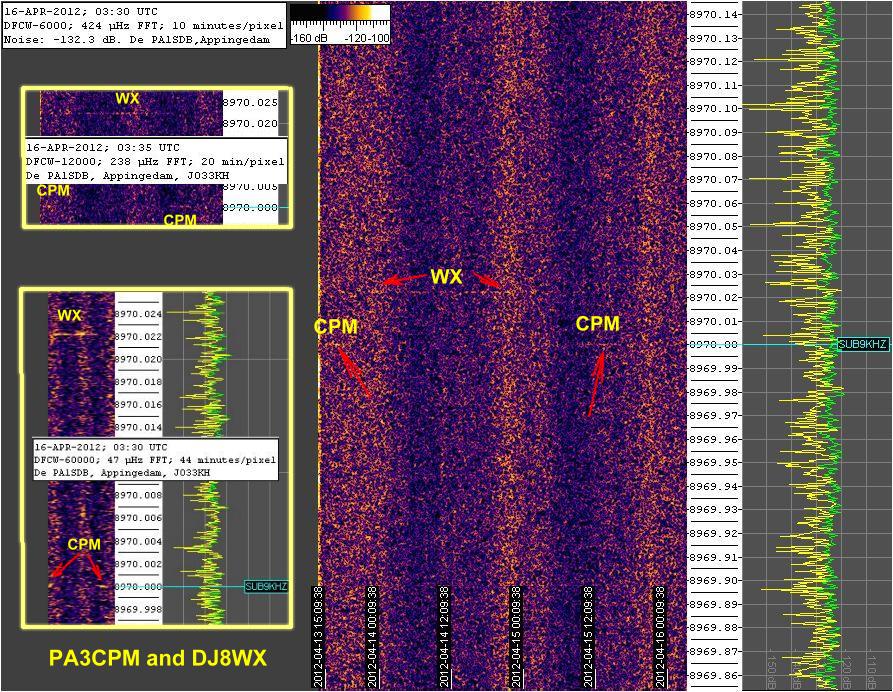
12 April 2012:
Uwe, DJ8WX did confirm today that he was on the air and that he was
testing a new aerial. The distance to DJ8WX is 187 Km.
Below a visual summary of yesterday's results:
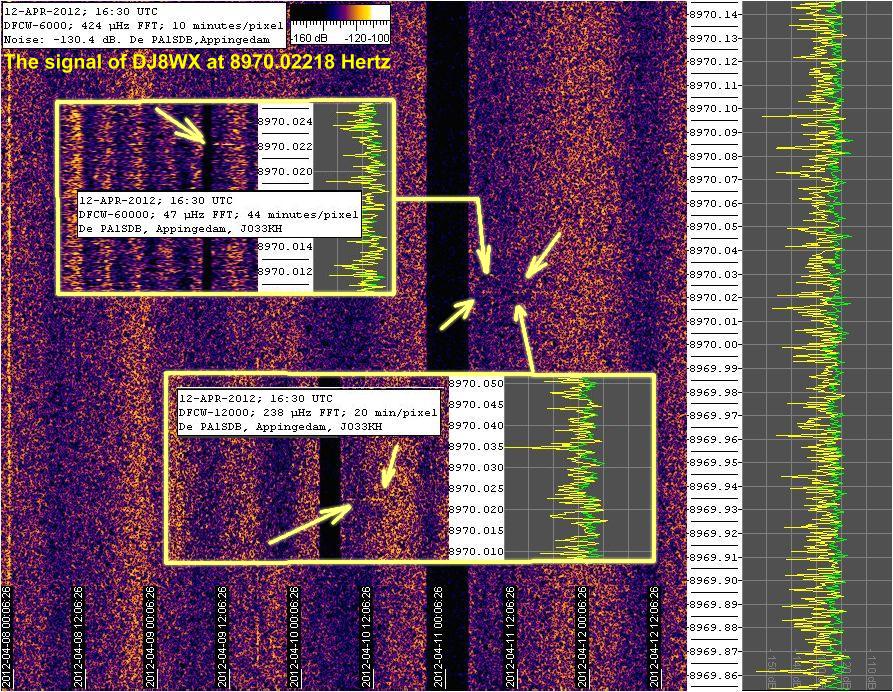
11 April 2012:
In my information request at the RSGB_VLF mail reflector about the
activity that I see at 8970,02218 Hertz, Stefan, DK7FC wrote:
:-) Exciting, isn't it?! Congrats, this is your 2nd VLF
reception of an amateur.
He will tell you personally who and where he is.
We, the others already know it :-)
10 April 2012:
I still use a motor battery to power the active Mini Whip antenna. That
battery voltage did drop below 11 volt and I need to load it again.
That's why there are black lines between between about 20H and 04 H UTC
today.
5 April, 2012:
This are the Spectrum Lab .USR files I'm using now for 424 uHz, 238 uHz
and 47 uHz. Won't say they are perfect, but as illustration...
8970_424uHz.USR - 8970_238uHz.USR
- 8970_47uHz.USR
4 April, 2012:
I took down the Mini Whip prototype who was fitted in a large and
oversized tube, and build it into a PVC tube that fits much better. The
PCB is now free from the tube / housing wall and is not able to knock
against the wall anymore like the prototype did. Perhaps there was some
microphonic effect earlier this week.
3 April, 2012:
Below a overview of the results while PA3CPM was on air. On the 1th of
April you can see that earlier mentioned drift. He was on the air for
abt. 8 hours. After a break during the night, the transmitter went back
on the air for another 8 hours on the 2nd of April. The synthesizer was
on and did stabilliz over the night. The signal was clear and straight
visible at 8970,000 Hz here. On the 2nd of April I did increase scroll
speed of that 47uHz spectogram (inlay's). Thats why pixels are a bit
blurred... As you can see scroll speed is very slooooooowwwwwww....
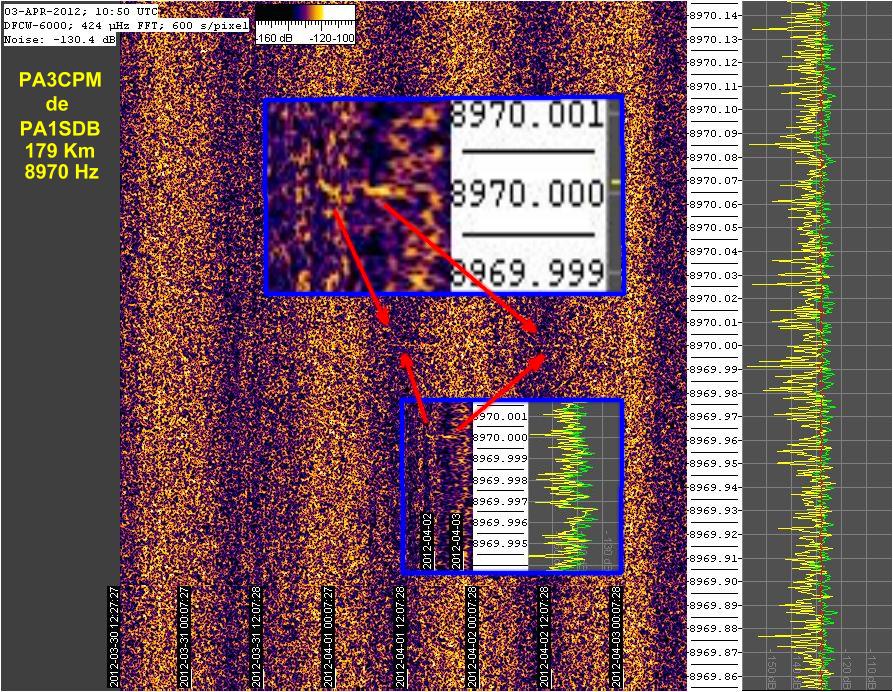
1th of April, 2012:
Besides "a special test transmission by a number of radio
amateurs on 11.6uHz", where also DK8KW, DJ2LF and DF6NM on the
air on 8970 Hz. Also PA3CPM was QRV at that time on 8970 Hz. Who I
actualy captured is not clear for me, but there was something visible on
8970,00 Hz. The Spectrum graph (yellow graph) shows a clear peak at
8970.000 Hz.

In the Spectogram below are also tiny traces visible of
,most likely, human origin ;-)
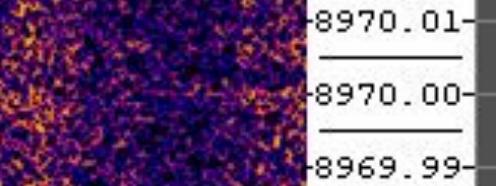
Via the mail reflector I did ask who was responsible for
the signal drift. PA3CPM wrote in dutch and translated by Google the
following message:
" Ha die Peter, It is my signal on 8970 Hz, the drift
is because the synth. must warm up, he always remains normal
"
28 March, 2012:
After 24h of digging in the noise is this the result for today:
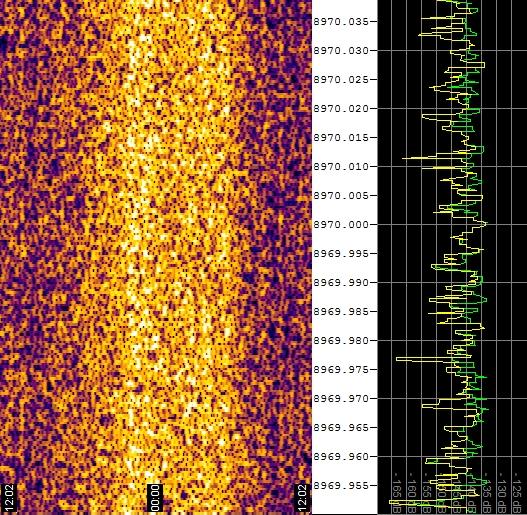
I think there where traces visible of DF6NM on 8970.002 Hz during the
night
DJ8WX on 8970.022 is also clear visible.
PA3CPM is detected as I wrote yesterday, but very weak on 8970,000 Hz
Well.... all 3 stations are very weak here. But for now
I know where I'm technicaly stand now. Now I have to adjust parameters
to increase the signal and lower the noise. Unfortunately it takes
soooooooooo much time befor something becomes visible at the screen.
Next week I will build a 2nd Mini Whip. Then it's possible to do some
more experiments on a 2nd PC and leave the other one untouched and use
it as a reference.
27 March, 2012:
Yesterday I did a test on 137 KHz with the Mini Whip.
DK7FC was loud and clear at the ALINCO DX70 receiver...

The powering problem is not solved yet. I tried several
power supplys and also tried a L8712 regulator. The noise was still
visible.
Right now I'm using my 10 Ah Suzuki - GS550L motor battery...
DJ8WX and PA3CPM are on air now. But did not see
anything. At about 11H UTC I did add about 3 meters to the antenna hight.
The antenna is now about 6 meters above ground level.
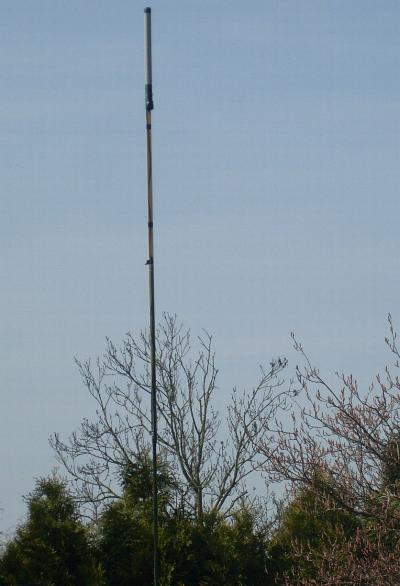
D I D I
C A T C H M Y F I R S T
F I S H ?
It looks like that I did catch PA3CPM, Henny in QTH
Maarssen on 8970 Hz this afternoon over a distance of 179 Km.
Between all those random pixels is a straight line visible on exact 8970
Hz. Just after I did add those 2 - 3 meters of
antenna hight, a trace became visible at 8970 Hz.
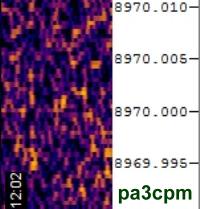

1) There is a straight line between random noise pixels.
2) The frequency is exactly the same where PA3CPM is transmitting at.
3) PA3CPM was ON THE AIR at that moment.
In my opinion it's no coincidence anymore that I see
something that looks like signals made by human species.
YESSSSSSSS, my first succes !!!
25 March, 2012:
O o o o o
o o o o o o o o o oooopsssss s s s
s s.....
Today I did discover that the used power supply for that Mini Whip has
very much effect on the reception results. Below a overview of some
experiments... The regulated power supply's make a mesh of the RX
spectrum.
A HQ Power(tm) PS1302 13.8 volt DC
regulated power supply.
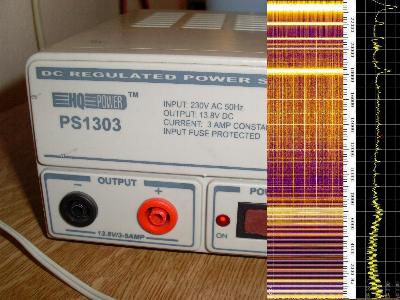
Take a look on that spectrum. A lot of noise around 8 KHz...
Also a mesh below 8 KHz. |
A SKIPTECH RPS1210 HQ regulated
power supply:
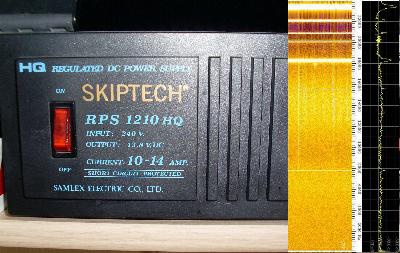
Wow.... noise all over the place... |
A 9 Volt battery:
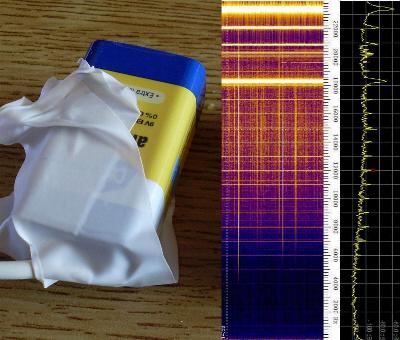
Sssssssssilence.... Almost no noise at 8970 Hz... |
8x Penlight:
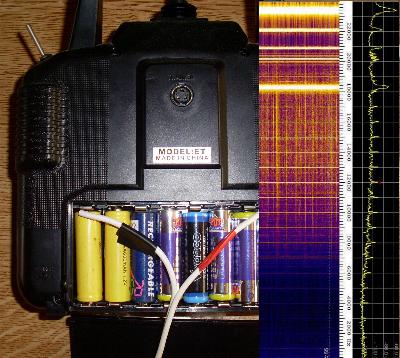
Sssssssssilence.... Almost no noise at 8970 Hz... |
Take a look at the 23 March screendump and this screen dump below. No
mesh anymore around 6.8 KHz...

Not sure how to fix that noise problem. I can't use
alway's those battery's.
23 March, 2012:
E U R E K A, it works... Not normal how strong the signals
are that come from that Mini-Whip's tiny antenna surface. RSDN-1 and
RSDN-2 around 12 KHz are also loud and clear now. This is how it looks
in "SAQ panoramic VLF receiver" written bij Johan Bodin,
SM6LKM. RSDN-2 on 12,65 Khz is just peaking in the blue filter window...
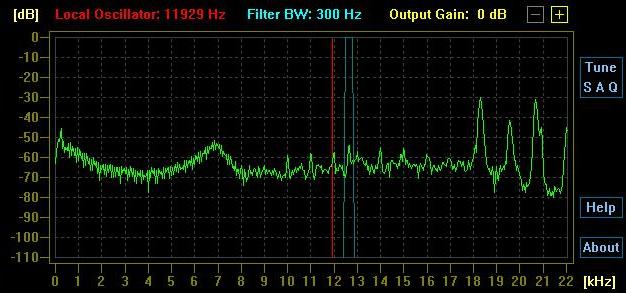
I'm not sure why there is a width peak around 6.8 KHz.
How do I callibrate Spectrum Lab ?
Wolf, DL4YHF wrote: You could check the calibration by switching the
spectrogram's center frequency to 11.9047601 kHz (Russian 'Alpha' on
that frequency is currently active). It's not an ideal check because of
the periodic signal....
22 March, 2012:
Almost ready to build that PA0RDT "Mini Whip(C)"
components together. Today I made the PCB's... Unreal when you see that
tiny antenna surface. Will that realy do the job on 9 KHz ? I hope to
compare it very soon with the two passive Loop antenna's that I'm
testing right now.
21 March, 2012:
Spectrum Lab setting's still on 423 uHz, but other antenna. This
time I'm using a loop with a circumference of 2.6 meters. PA3CPM and
DJ8WX where almost continue on the air at that time. When the local
noise is low, then I think to see something on exact 8970 Hz, but not
sure. There was a large increasement of signal when I did switch from
the tiny F&G loop to the homebuild 2.60m circumference loop as you
can see below...
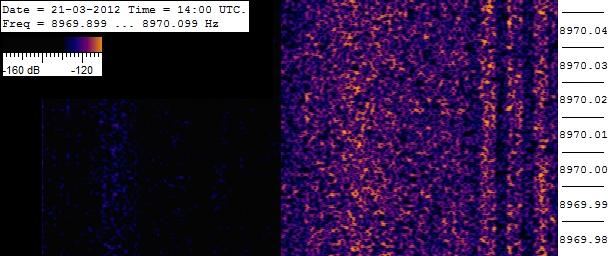
Today I did adjust the Spectrum Lab settings to 44 uHz
and a scrol speed of 23 minutes. Let's see what did happen on the 22th
of March. My electronic components for the Mini Whip did arive today via
mail. When I have time this week I will build that antenna and compare
it with my non active loop's...
20 March, 2012:
Today I did order some J310 Fet's and 2N5109's the HF choke coils
with the intention to build a Mini-Whipe©
by PA0RDT.
Take a look at this PDF document (Dutch) http://www.qsl.net/pa1sdb/electron_may_2006_pa0rtd_miniwhip.pdf
19 March 2012:
There was a lot of activity on 8970Hz this weekend. At least
"3" station where there, DK7FC, PA3CPM and DF6NM. I was using
a Loop antenna without amplifier. The Loop was located in the backyard
at 20m distance from the house. Only 1 meter above the ground. I think I
did'nt see anything in the spectogram. FTT-bin size 423 uHz.

|

















